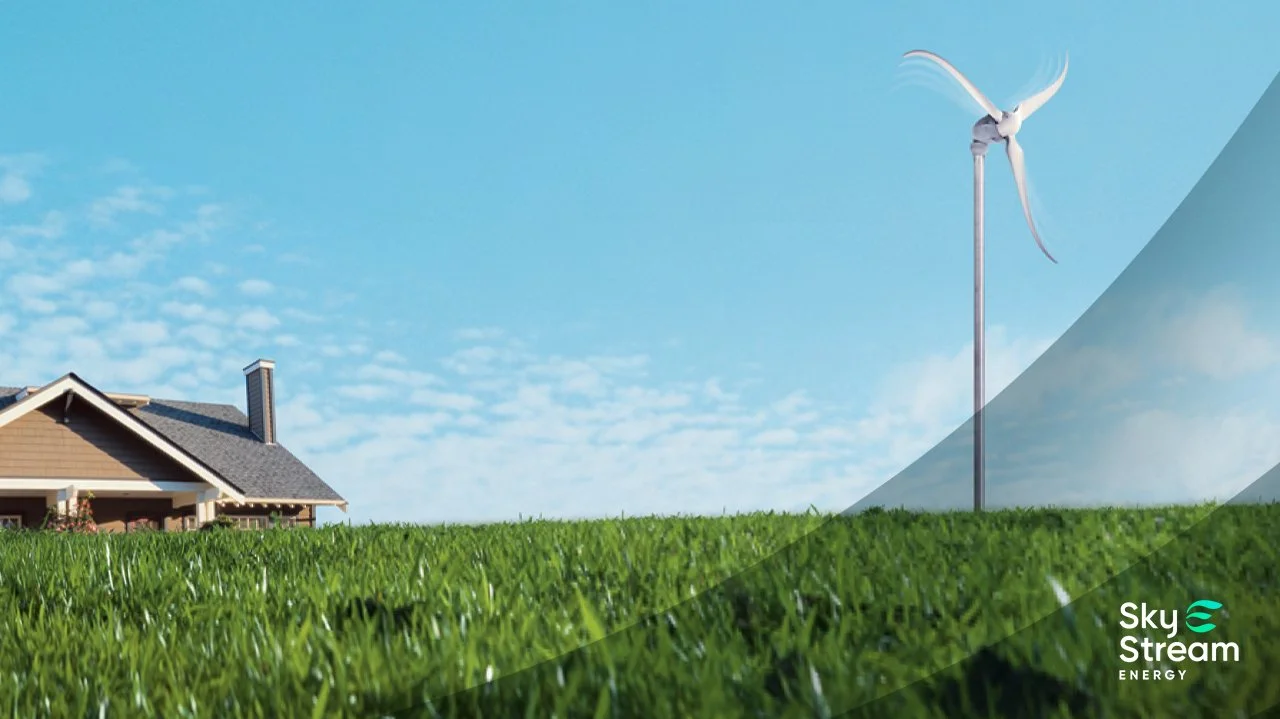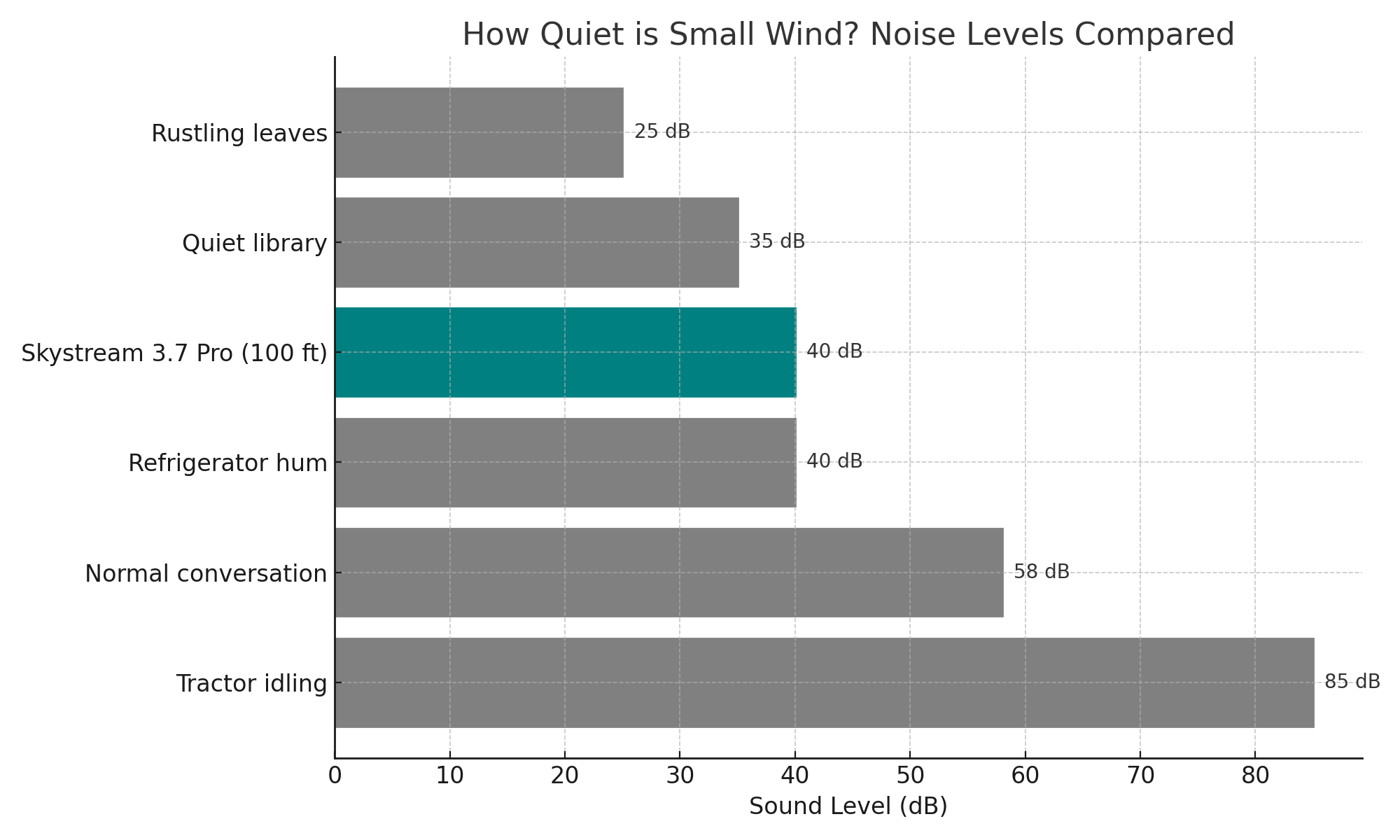Quiet Power: Debunking the Noise Myth Around Wind Turbines
When people think of wind turbines, they often picture giant utility-scale machines and assume they’re noisy. For small wind systems like the Skystream 3.7 Pro, this outdated perception doesn’t hold. Modern engineering has made small wind quiet enough to blend seamlessly into rural homes, farms, ranches, and microgrids.
According to the U.S. Department of Energy’s Wind Turbine Sound guide, most modern small wind turbines create sound only slightly above the ambient wind itself. DOE notes that researchers continually measure turbine acoustics and advance technologies to reduce noise. While those studies cover the industry broadly (not Skystream specifically), they confirm the same trend that Skystream’s manufacturer testing shows: modern small wind is designed to operate at everyday background sound levels.
Let’s break down the facts, measurements, and engineering behind quiet wind power.
Measuring the Sound of Small Wind
Noise is measured in A-weighted decibels (dBA), a logarithmic scale that reflects how the human ear hears sound. Even small differences in dBA can feel significant.
For context, here’s how the Skystream 3.7 Pro compares to everyday sounds:
Noise levels shown in A-weighted decibels (dBA). Skystream 3.7 Pro rated ~45 dBA @ 40 ft. At 100+ ft (typical install distance), it blends into background noise.
The Engineering Behind the Silence
Modern small wind turbines are specifically designed to minimize acoustic impact:
• Aerodynamic blade design: Swept, tapered blades reduce turbulence and keep tip-speed noise low, eliminating the “whooshing” sound of older turbines.
• Direct-drive technology: A permanent-magnet, gearless alternator removes the gearbox entirely, another one of the primary historical sources of turbine noise.
• Advanced composites: Blades and nacelle materials dampen vibration and resonance, helping prevent tonal “pure tones” that the human ear notices most easily.
• Precision balance and bearings: Factory rotor balancing and friction-reducing bearings prevent tower hum, keeping operation nearly silent.
• Continuous monitoring: With Skystream 3.7 Pro, dealer service and performance tracking keeps the system tuned and acoustically consistent over time.
Why Noise Control Matters
Silence isn’t just a design feature. It’s a customer demand across different markets:
• Farms & Ranches: Livestock and wide-open land call for systems that won’t disturb animals or natural soundscapes.
• Residential Homes: Families want energy independence without sacrificing peace and quiet.
• Eco-tourism & Education: Resorts, parks, and schools need turbines that demonstrate sustainability without disrupting experiences.
• Utilities & Co-ops: Distributed energy must be community-friendly. Quiet operation ensures smooth adoption.
The DOE also emphasizes that noise control is central to permitting and community acceptance. The DOE’s WindExchange handbook notes that developers are typically required by local ordinances to demonstrate compliance with sound-level regulations, often using acoustic modeling before and after installation.
Skystream’s site assessments follow the same principle, providing property-specific sound contours so owners, and neighbors, know what to expect.
Real-World Results
Across Skystream installations, owners often say the only reminder their turbine is running comes from their lower electricity bills or stable microgrid performance, not from any audible noise.
Dealers report no recorded noise complaints to date across residential and rural installs.
Quiet by Design
The “noisy wind turbine” is a myth rooted in outdated technology and confusion with large utility-scale machines. The redesigned Skystream 3.7 Pro proves that small wind can be quiet, reliable, and hybrid-ready. With sound levels around 45 dBA at 40 ft (about the hum of a refrigerator) noise is no longer a barrier to wind power. It’s a myth from another era.
For farmers, ranchers, homeowners, and communities, this means renewable energy that delivers independence and savings without sacrificing peace and quiet.
Interested in hearing the difference for yourself?
Schedule a site assessment and receive a property-specific sound contour map along with a hybrid wind + solar system design.


